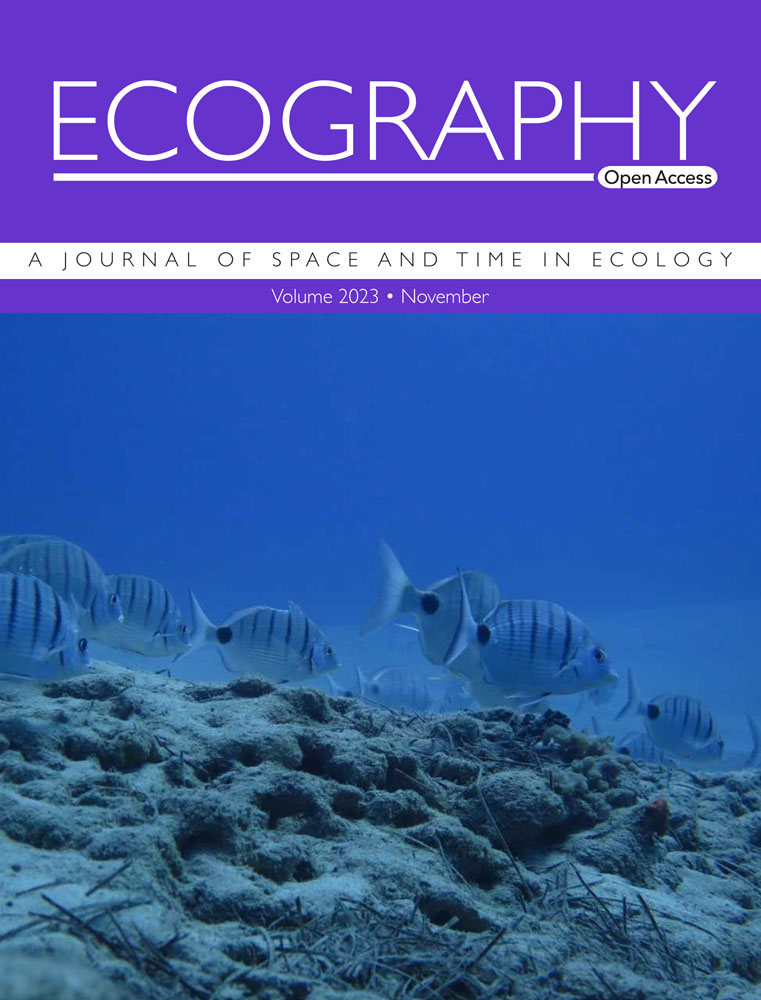大多数嫩叶比成熟叶苍白:延迟绿化既不是二元的也不是热带的
IF 5.4
1区 环境科学与生态学
Q1 BIODIVERSITY CONSERVATION
引用次数: 0
摘要
延迟变绿,即由于叶绿素含量低而膨胀的叶子呈现红色、蓝色或淡绿色的现象,长期以来一直引起生态学家的兴趣。然而,对于什么类型的物种最有可能延迟绿化,或者哪些环境条件与延迟绿化有关,人们知之甚少。我们对分布在16°S到43°S的12个代表性陆地生态系统的105种植物的叶片色素进行了光谱定量,并以扩张叶和成熟叶的平均叶绿素含量的对数比来评估延迟绿化。与传统的延迟绿化的二元观点相反,我们观察到延迟绿化物种的水平呈正态分布,膨胀叶片的叶绿素含量平均为成熟叶片的一半。令人惊讶的是,在延迟绿化水平上没有显著的纬度梯度。草食性与延迟变绿水平无相关性,但与花青素水平呈正相关。土壤pH值接近中性的样地延迟绿化水平较低,叶表面积和叶质量较高的样地延迟绿化水平较高,与土壤速效氮和有机碳含量无关。我们认为,在离散类别中考虑连续变量的传统可能会影响研究人员思考特征的方式,并可能阻碍理解生态策略的进展。本文章由计算机程序翻译,如有差异,请以英文原文为准。
Most young leaves pale in comparison to mature leaves: delayed greening is neither binary nor tropical
Delayed greening, the phenomenon in which expanding leaves appear red, blue or pale green due to low chlorophyll content, has long intrigued ecologists. However, little is known about what type of species are most likely to delay greening or which environmental conditions are associated with delayed greening. We spectroscopically quantified leaf pigments in 105 species from 12 representative terrestrial ecosystems, spanning from 16°S to 43°S, and assessed delayed greening as the log ratio of the average chlorophyll content in expanding and mature leaves. Contrary to the traditional binary view of delayed greening, we observed a normal distribution in the level of delayed greening species have, with expanding leaves containing, on average, half the chlorophyll of mature leaves. Surprisingly, there was no significant latitudinal gradient in the level of delayed greening. Herbivory showed no correlation with the level of delayed greening but a positive association with anthocyanin levels. Delayed greening levels tended to be lower in sites with near-neutral soil pH, greater in plant species with higher leaf surface and leaf mass per area, and exhibited no association with soil available nitrogen and organic carbon content. We suggest that a tradition of considering continuous variables in discrete categories can affect the way researchers think about a trait and potentially impede progress in understanding ecological strategy.
求助全文
通过发布文献求助,成功后即可免费获取论文全文。
去求助
来源期刊

Ecography
环境科学-生态学
CiteScore
11.60
自引率
3.40%
发文量
122
审稿时长
8-16 weeks
期刊介绍:
ECOGRAPHY publishes exciting, novel, and important articles that significantly advance understanding of ecological or biodiversity patterns in space or time. Papers focusing on conservation or restoration are welcomed, provided they are anchored in ecological theory and convey a general message that goes beyond a single case study. We encourage papers that seek advancing the field through the development and testing of theory or methodology, or by proposing new tools for analysis or interpretation of ecological phenomena. Manuscripts are expected to address general principles in ecology, though they may do so using a specific model system if they adequately frame the problem relative to a generalized ecological question or problem.
Purely descriptive papers are considered only if breaking new ground and/or describing patterns seldom explored. Studies focused on a single species or single location are generally discouraged unless they make a significant contribution to advancing general theory or understanding of biodiversity patterns and processes. Manuscripts merely confirming or marginally extending results of previous work are unlikely to be considered in Ecography.
Papers are judged by virtue of their originality, appeal to general interest, and their contribution to new developments in studies of spatial and temporal ecological patterns. There are no biases with regard to taxon, biome, or biogeographical area.
 求助内容:
求助内容: 应助结果提醒方式:
应助结果提醒方式:


